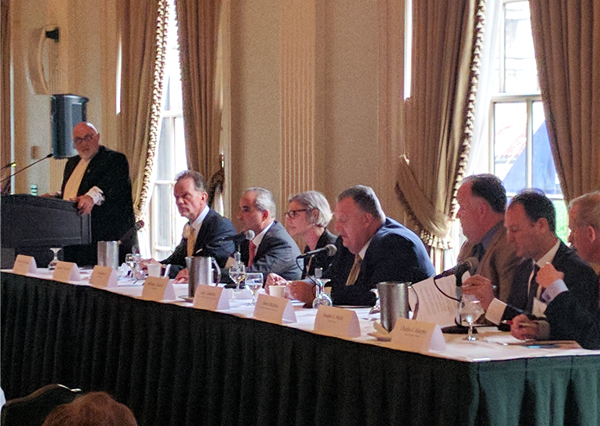Trending
What role will union construction play in the NYC of tomorrow?
Execs from SL Green, Tishman and Brookfield contemplate union labor's decreasing market share

A panel of owners, construction managers and labor leaders assembled Wednesday at The Union League On Park Avenue to discuss the future of union construction labor in a city that’s increasingly open shop.
At the panel — hosted by law firm Zetlin & De Chiara and moderated by founding partner Michael De Chiara — former New York Building Congress president Richard Anderson said there was good news: building permits are finally up, 145,000 people are working on job sites throughout the boroughs and the office market is strong with big-ticket projects in the pipeline. “What could threaten this kind of a robust portrait?” he asked. The answer, panelists said, was sky-high costs.
New York is the most expensive city in the world to build, largely due to high construction wages and rising material costs, a recent study by consultancy firm Turner & Townsend found. The average cost of construction hit $354 per square foot in New York City last year, the study claimed.
Sabrina Kanner, of Brookfield Property Partners [TRDataCustom], which has a portfolio-wide project labor agreement, said that Brookfield’s labor decisions come straight from the project budget. “We wouldn’t be having this discussion today if in fact construction costs hadn’t gone up 25 percent in the last five years,” she said, “…something has to give.”
Edward Piccinich, SL Green’s director of property management and construction, said that doing 100 percent union was the way to go on the 1,300-foot skyscraper development One Vanderbilt near Grand Central Terminal, because of the speed and quality the unions offer over many open-shop groups. “But that’s not to say we don’t bid our jobs open shop,” he said. “When that word open shop is thrown out to me, that’s just another way of saying competition … and I think competition’s good…”
So called-open shop construction sites, or those that do not use entirely union labor, are now a basic market reality in the residential sector, but it’s creeping into other construction types, too, a trend that panelists seemed to regard as inevitable.
“Commercial is switching over,” said Charles Murphy, of Turner Construction, one of several New York City construction firms to last year refuse to sign agreements to exclusively use organized union labor, according to Wall Street Journal. Murphy cited the Brooklyn Navy Yard office project (where a dozen nonunionized ironworkers recently walked off the job at Rudin Management and Boston Properties Dock 72) as a prominent open-shop office building example.
Jay Badame, president and COO of construction manager AECOM Tishman (the largest general contractor in the city), downplayed the role of construction companies in making big labor deals. “We’re all brought here by our clients and the developers, and the developers are really driving the ship and a lot of them are members of the organization called REBNY,” he said, “so we are really just at their beck and call as it relates to open-shop and nonunion.”
But unions are adapting to land big contracts. Panelists noted that they’re picking up on a tactic familiar to most landlords: offering significant concessions.
“Unions are making concessions like never before,” De Chiara said. But one problem construction managers and unions encounter, he said, is that subcontractors often don’t keep up their end of the bargain in contract negotiations, and don’t adhere to cost saving concessions, such as relaxing certain labor rules or agreeing not to strike. “People in our industry are not looking to take money out of people’s pocket” said Joseph Mizzi of Sciame Construction firm, adding that making sure subcontractors aren’t siphoning off money is a key part of making project labor agreements work.
Steve McInnis, president of the NYC District Council of Carpenters, said one of the worst ways that nonunion shops are trying to skimp, however, is by being “willing to overpay the management and under pay the workers.” Some builders think they are getting a deal by bringing on top supervisors, McInnis said, but in the end they get straddled with an ill-suited labor force that no experienced manager can fix. Mizzi later added that wage concessions were in his experience the least effective form of concessions and had a tendency to produce “less than stellar” workers.
Gary LaBarbera, president of the Building and Construction Trades Council of Greater New York who was recently nominated by Gov. Andrew Cuomo to the board of the Port Authority of New York and New Jersey, cautioned the panel and the audience to remember that many open-shop projects are still majority union.
LaBarbera frequently said there were perils in using nonunion labor, such as inferior safety and poor quality of work, and made an example of the meager wages many non-organized workers are receiving. “You have workers that working 50 or 60 hours a week but are being paid at 40 hours a week, 15 dollars an hour, cash, no benefits, many of them undocumented workers,” he said. Most fatal accidents in the recent years have happened nonunion jobs as well, he added. “There’s a real cost to this and the cost is the worker. The worker is being exploited.”
In the end, LaBarbera said trade unions have been making strides to compensate for lost market share, reworking contracts to be more competitive and finding ways to reduce the hourly aggregate cost of labor. “We know what contractors are doing, we know what they’re paying,” he said. “Building trades is open for business. There’s a lot of changes that have been made.”




